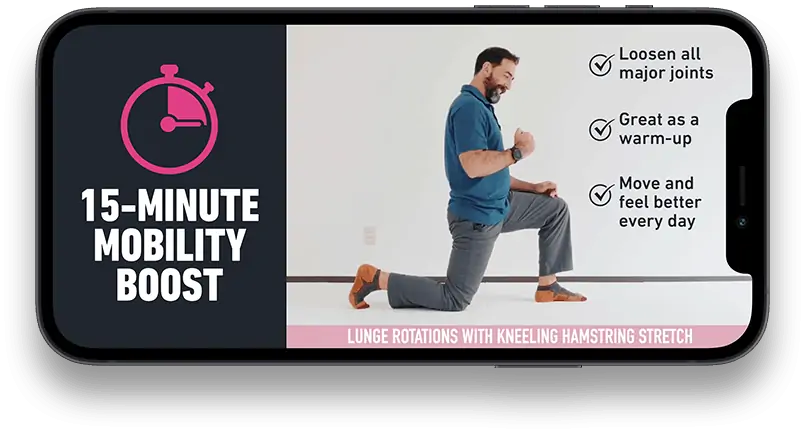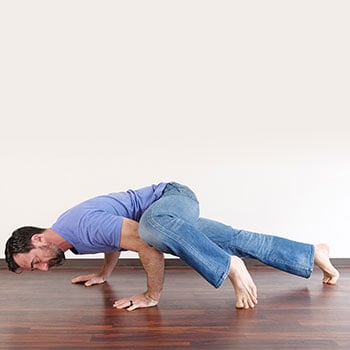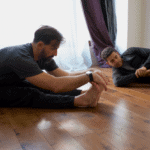Hip pain can be simply nagging or downright debilitating. It’s one of those areas we don’t think too much about until something happens and then we have to deal with it.
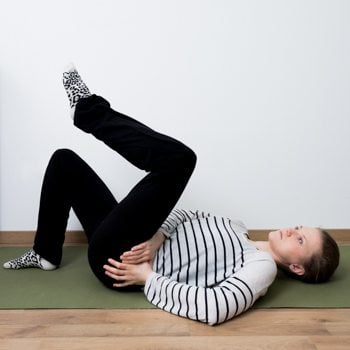 Why is hip pain so bad?
Why is hip pain so bad?
Well, for one thing, it’s very hard to simply just avoid movements that exacerbate your pain. Pretty much every action–from walking, to climbing stairs, to sitting–involves the hip joints. So if you’re in pain, you may be feeling it all day long.
Here’s what you’ll find in this article:
So, let’s get you past this!
What Could Be Causing Your Hip Pain?
 When people talk about pain in their hips, they rarely mean only the hip joints themselves.
When people talk about pain in their hips, they rarely mean only the hip joints themselves.
The hips are part of a large network of joints and ligaments, so when we refer to “the hips,” it’s pretty ambiguous and can mean many different parts of this region.
And often, when people have hip pain (regardless of which part of the hip is problematic), they often have issues in other parts of the body, specifically low back and knees. All of these parts work together (and share some nerves), so when there’s trouble in one, there’s often trouble in the other.
If you have knee pain, see our accompanying article on how to keep your knees healthy. And here’s some great information to help your back.
Before we get into the meat here, I just want to remind you that the information in this article is no substitute for being seen by a professional in-person if you have ongoing issues–particularly related to pain or weakness. There are certain rare, but serious conditions that can cause hip pain, and those conditions must be treated by a physician.
Okay, let’s keep going 🙂
When we discuss pain in other parts of the body, we almost never distinguish between men and women, because there’s rarely a difference. But with the hips, it’s useful to look at the details separately, since the anatomy, as well as the strains on this region, can be quite different for men and women.
Hip Pain in Women
 In general, when women experience hip pain, they are often dealing with discomfort throughout the pelvic region. Anatomically, women have a wider pelvis than men, which distributes the forces differently.
In general, when women experience hip pain, they are often dealing with discomfort throughout the pelvic region. Anatomically, women have a wider pelvis than men, which distributes the forces differently.
We tend to hear about hip pain more from our female clients than from our male clients, especially from clients who are pregnant or have recently had a child.
This is for a couple of primary reasons:
- During Pregnancy–The body releases a hormone called relaxin, which loosens the ligaments to prepare the pelvis for the passage of the baby through the birth canal. This is great for the birth itself, but throughout the rest of the pregnancy, it can cause all sorts of problems in the pelvis (as well as other parts of the body), due to lack of stability in the ligaments.
- After Pregnancy–The ligaments stay loose for a while after delivery, but another common issue can cause pain in the hips/pelvis after having a baby, and that’s how you hold your baby. Many women (because of their naturally wider hips) tend to hold the baby on one hip or the other, jutting that hip outward to create a “shelf” for the baby. This is okay, of course, for short periods of time, but for women who spend much of their day holding a baby in this way, it can cause quite a bit of pain over time.
For women who have never been pregnant, there are still different forces at play due to the wider pelvic bowl, which creates a different angle from the hip to the knee than in men.
Hip Pain Sucks. 😫 But There’s Relief In Your Future…
Be like the 0 GMB clients and start loosening up those tight hip flexors and glutes. Grab our 15-Minute Mobility Boost 👉 Click here to download it.
Hip Pain in Men
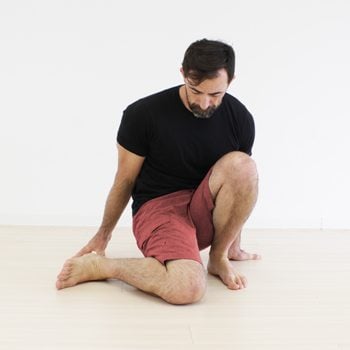 For men, hip pain more often manifests as pain in the glute and hip flexor areas.
For men, hip pain more often manifests as pain in the glute and hip flexor areas.
Pain in these regions often stem from lack of movement, and is particularly common in people with sedentary lifestyles. Even if you train pretty hard a few times a week, if you sit most of the day and don’t take the time to get your hips moving, you may feel discomfort in these spots.
Going through the routine below even a few times a week can be a big help, along with doing hip stretches on a regular basis.
Fix Your Hip Pain With This Daily Routine
This routine contains simple exercises to strengthen and mobilize the area around the hips.
Rose Calucchia (Lead GMB Trainer and a member of our support staff) is demonstrating the exercises, and may show the exercises at a more advanced level than you can do right now. That’s okay. Just work at your own level, and don’t force yourself into positions that exacerbate your pain.
| Exercise | Description |
|---|---|
| Step Back Lunges to Kneeling Lunge Stretch | • Keep your weight on the heel of the front leg and bring your back leg back touching the knee down to the ground. • For the stretch, think about keeping your chest up and pull your hips underneath you. |
| Squats to Modified Pigeon Stretch | • For the Squat keep your chest up high, the weight in the middle of your feet to your heels and sit back. • For the Modified Pigeon Stretch keep your back leg bent. Shift your weight towards the front knee, with chest kept up high. |
| Side to Side Squats to Side Squat Stretch | • For the Side to Side Squats try to keep your hips as low as possible as you shift over from one side to the other. • For the Stretch portion think about bringing your bent knee to the side more . You can press your hands forward to find balance or put more weight forward if you need to. |
| Sumo Squats to Frog stretch | • Start by standing tall, then step out into a wide squat where you actively push your knees out to the side. • For the Frog stretch bring your knees apart on to the ground. Play with how wide apart your feet are to make it comfortable for you. Be careful not to sit back so much that it starts pinching the front of your hips. |
Keep Your Hips Out of Pain and Moving Well
If you’ve experienced hip pain, you know how much it can get in the way of your day-to-day function, as well as any of your favorite active pastimes.
The routine above should help you address the underlying weakness and dysfunction that is likely causing your pain. And as you feel ready to incorporate more movement into your routine, our GMB Mobility program can help you build up strength and mobility in your hips, as well as other key problem areas.
Build Flexibility That Actually Helps You Move
GMB Mobility is a guided program that improves your total body mobility. You’ll resolve restrictions so you can finally move and perform your best.

